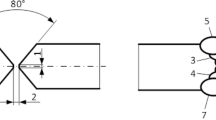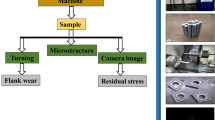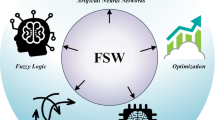Abstract
In this study, the effect of friction-stir welding (FSW) parameters such as spindle rotational speed, traverse speed, and stirrer geometry on mechanical properties of AA 1050/AA 5083 alloy couples were experimentally investigated. Ultimate tensile strength (UTS) and hardness of welded joints were determined for this purpose. The full-factorial experimental design was conducted to obtain the response measurements. Analysis of variance (ANOVA) and main effect plot were used to determine the significant parameters and set the optimal level for each parameter. A linear regression equation was derived to predict each output characteristic. The experimental and predicted values were in a good agreement with a R 2 of 0.82 and 0.93 for UTS and hardness, respectively.
Similar content being viewed by others
References
Thomas WM, Nicholas ED (1997) Friction stir welding for the transportation industries. Mater Des 18:269–273
Elangovan K, Balasubramanian V (2007) Influences of pin profile and rotational speed of the tool on the formation of friction stir processing zone in AA2219 aluminium alloy. Mater Sci Eng A 459:7–18 doi:10.1016/j.msea.2006.12.124
Okuyucu H, Kurt A, Arcaklioglu E (2007) Artificial neural network application to the friction stir welding of aluminum plates. Mater Des 28:78–84
Frigaard O, Grong O, Midling OT (2001) A process model for friction stir welding of age hardening aluminum alloys. Metall Mater Trans A 32:1189–1200 doi:10.1007/s11661-001-0128-4
Zhang HW, Zhang Z, Chen JT (2007) 3D modeling of material flow in friction stir welding under different process parameters. J Mater Process Technol 183:62–70 doi:10.1016/j.jmatprotec.2006.09.027
Fersini D, Pirondi A (2008) Analysis and modeling of fatigue failure of friction stir welded aluminum alloy single-lap joints. Engineer Fract Mech 75:790–803 doi:10.1016/j.engfracmech.2007.04.013
Buffa G, Fratini L, Shivpuri R (2007) CDRX modeling in friction stir welding of AA 7075-T6 aluminum alloy: analytical approaches. J Mater Process Technol 191:356–359 doi:10.1016/j.jmatprotec.2007.03.033
Fratini L, Buffa G (2005) CDRX modeling in friction stir welding of aluminum alloys. Int J Mach Tools Manuf 45:1188–1194 doi:10.1016/j.ijmachtools.2004.12.001
Chen CM, Kovacevic R (2003) Finite element modeling of friction stir welding—thermal and thermomechanical analysis. Int J Mach Tools Manuf 43:1319–1326 doi:10.1016/S0890-6955(03)00158-5
Wang Y, Mishra RS (2007) Finite element simulation of selective superplastic forming of friction stir processes AA 7075 Al alloy. Mater Sci Eng A 463:245–248 doi:10.1016/j.msea.2006.08.118
Heurtier P, Jones MJ, Desrayaud C et al (2006) Mechanical and thermal modeling of friction stir welding. J Mater Process Technol 171:348–357 doi:10.1016/j.jmatprotec.2005.07.014
Lockwood WD, Tomaz B, Reynolds AP (2002) Mechanical response of friction stir welded AA 2024: experiment and modeling. Mater Sci Eng A 323:348–353 doi:10.1016/S0921-5093(01)01385-5
Kamp N, Sullivan A, Robson JD (2007) Modeling of friction stir welding of 7xxx aluminum alloys. Mater Sci Eng A 466:246–255 doi:10.1016/j.msea.2007.02.070
Bastier A, Maitournam MH, Roger F, et al (2007) Modeling of the residual state of friction stir welded plates. J Mater Process Technol. doi:10.1016/j.jmatprotec.2007.10.083
Khandkar MZH, Khan JA, Reynolds AP et al (2006) Predicting residual thermal stresses in friction stir welded metals. J Mater Process Technol 174:195–203 doi:10.1016/j.jmatprotec.2005.12.013
Simar A, Brechet Y, Meesser B et al (2007) Sequential modeling of local precipitation, strength and strain hardening in friction stir welds of an aluminum alloy 6005A-T6. Acta Mater 55:6133–6143 doi:10.1016/j.actamat.2007.07.012
Ulysse P (2002) Three-dimensional modeling of the friction stir-welding process. Int J Mach Tools Manuf 42:1549–1557 doi:10.1016/S0890-6955(02)00114-1
Benyounis KY, Olabi AG (2007) Optimization of different welding processes using statistical and numerical approaches—a reference guide. Adv Eng Softw 39:483–496
Naidu R (2006) Friction stir welding: Thermal effects of a parametric study on butt and lap welds. M.S. Thesis, Bachelor Engineering, Shivaji University, India
Khaled T (2005) An outsider looks at friction stir welding. Federal Aviation Administration. Report ANM-112N-05-06-FAA-USA http://www.faa.gov/aircraft/air_cert/design_approvals/csta/publications/media/friction_stir_welding.pdf
Palanikumar K, Kartikeyan R (2006) Optimal machining conditions for turning of particulate metal matrix composites using Taguchi and response surface methodologies. Mach Sci Technol 10:417–433 doi:10.1080/10910340600996068
Zarepour H, Tehrani AF, Karimi D et al (2007) Statistical analysis on electrode wear in EDM of tool steel DIN 1.2714 used in forging dies. J Mater Process Technol 187–188:711–714
Author information
Authors and Affiliations
Corresponding author
Rights and permissions
About this article
Cite this article
Sarsılmaz, F., Çaydaş, U. Statistical analysis on mechanical properties of friction-stir-welded AA 1050/AA 5083 couples. Int J Adv Manuf Technol 43, 248–255 (2009). https://doi.org/10.1007/s00170-008-1716-x
Received:
Accepted:
Published:
Issue Date:
DOI: https://doi.org/10.1007/s00170-008-1716-x




